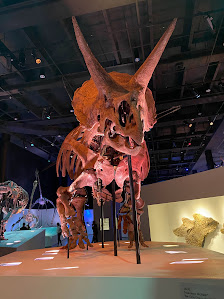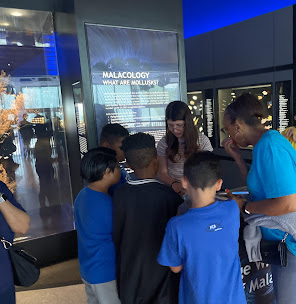Day 2: Visiting the Dinosaurs!
Beginning today's blog by saying that I was able to visit the paleontology exhibit today, I think, would be a good place to start.
I started off similar to yesterday morning: I arrived at the museum, got signed in, and met with Ms. Leap to get some research papers to get me started with the chosen exhibit of the day... the Morian Hall of Paleontology!
The most notable thing that I took notice of upon arriving at the exhibit is that it was not stagnant, instead all the displays were in the midst of action. All the specimens were in a vivid struggle for survival — engaging in hunting, eating and escaping — where we are simply spectators to this "active" walkthrough.
I actually crossed paths with another M-Term taking a trip to the paleo exhibit when I arrived, and ended up having an intricate and very detailed tour done by another of my classmates! This was very helpful as an introduction to the research, and was very much appreciated. We toured through the exhibits, which is cleverly built to lead you in chronological order of events if you go through it clockwise, and got to see beautiful displays from the Precambrian "age of early life" through the Cenozoic era of "recent life" (today).
While I have always found this subject to be interesting, this is the first time I've really studied it to this extent, so saying that today was especially productive would not be a stretch.
Here are some of my favourite displays from today:


 |
| Steneosaurus |
This next big guy is a steneosaurus, a crocodilian species from the early Jurassic. Unlike most crocodile species today, these sea-crocodiles were more venturesome and hunted in open waters. This is due to its body which easily allowed for ocean life. For example, while modern-day crocs have stronger fore-legs and can run on land, these Jurassic sea-dwellers had weaker and shorter front legs which were excellent for swimming but not so great for walking. Their powerful tails allowed for underwater propulsion, and their hind legs were good to back up. Interestingly enough, the armour plates on its back and stomach was kept through millions of years of evolution and is a feature found even in freshwater crocodiles today.


Moving on from marine life, we see the diplodocus, a dinosaur who lived in the late Jurassic era, and stood at around 15 feet (4.5 m) tall. As you can probably imagine it was very large, long-necked, quadrupedal and had a very long whip-like tail. Fully grown and healthy, these creatures had no predators!
 |
| Triceratops |
This is Lane, the museum's triceratops, one of my personal favourites, and is an excellent skeleton, with some of the most complete features ever discovered! She is actually a mummy, one that was very well preserved, and is from the Cretaceous period.
 |
| Tyrannosaurus rex |
And one of the most popular species: tyrannosaurus rex! His name is Stan, is a blunt tooth scavenger, with an average height of 16 feet (4.8 m). (Fun Fact: you cannot see it from this angle, but he is missing a part of his tail.)
 |
| Diatryma |
This next creature is the diatryma, or the "terror bird," whichever floats your boat. As its nickname suggests, it was an absolute giant. Standing over 10 feet tall (3 m) and weighing more than 1000 pounds, this creature was a flight-less bird which sported an intimidatingly large beak. Luckily, it was not carnivorous, and ate mainly nuts, berries, and thick branches filled with sap.
 |
| Eremotherium |
Here is another giant, the eremotherium, or "slothzilla" as dubbed in its exhibit description. Active defense from this creature was mainly done by powerful swings of their front paws: a 10 ton eremothere had the strength to fling a sabre-toothed cat 30 feet! This species shows a basically enlarged sloth-design, with powerful back legs and long arms. However, they all went extinct around 10,000 years ago, due to the terminal Ice Age extinction — which was responsible for nearly all giant mammals across North and South America.
And moving towards the end of the exhibits, we have us...

... kind of anticlimactic...
But... that pretty much concludes what I did today at the HMNS. After that I made sure to document my research, and continued to do a bit of reading. For tomorrow, I am excited to meet Mr. Washington, who'll be able to give me insights into his work, and help guide the study to a more practical level. I can't wait!
To sum up, today was great! I think this was a good way to spend my time preparing to meet the professor, and it was a good introduction to these incredible creatures. To tomorrow!



Comments
Post a Comment